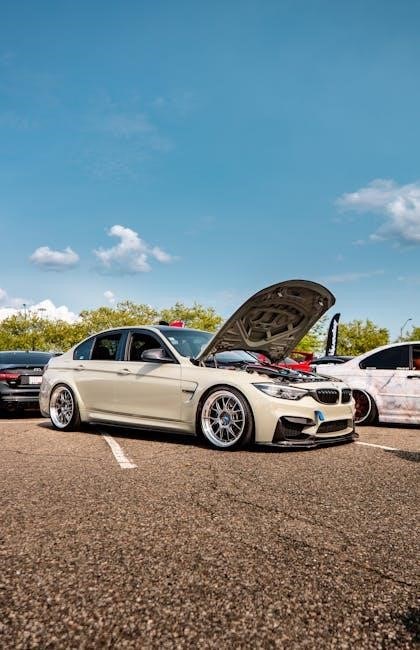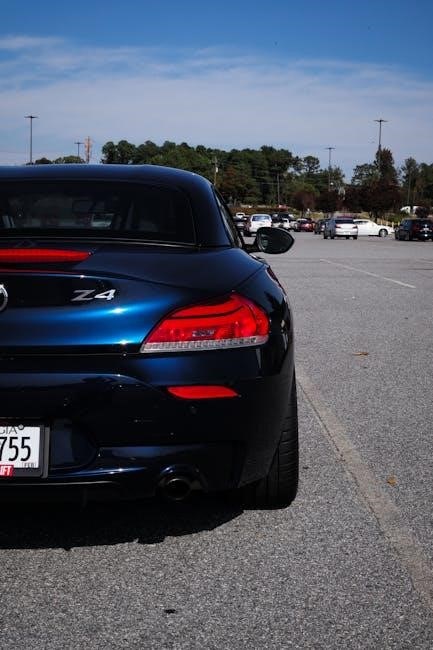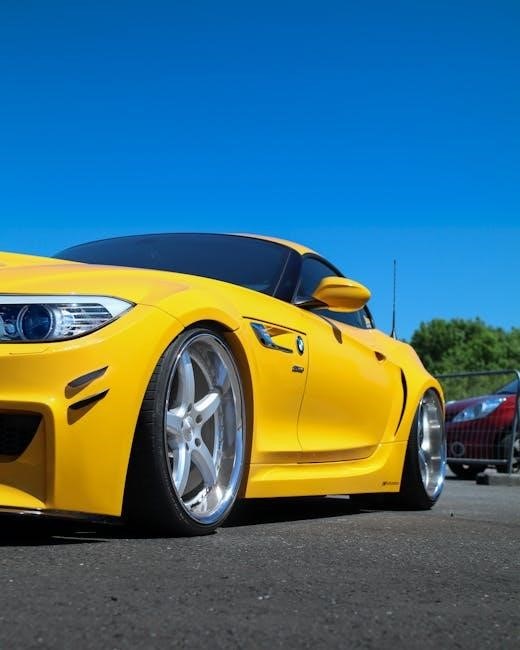This guide provides essential insights for potential BMW Z4 buyers, covering history, key features, models, maintenance tips, and expert advice to make informed purchasing decisions.
Overview of the BMW Z4
The BMW Z4 is a sleek and dynamic roadster known for its agility, style, and driving thrill. It combines classic roadster design elements with modern engineering, offering a unique blend of performance and luxury. Available in various generations, the Z4 has evolved to cater to diverse driving preferences, from casual cruising to spirited performance. Its lightweight construction, precise handling, and powerful engine options make it a standout in the sports car segment. Whether you’re seeking a refined daily driver or an exhilarating weekend companion, the Z4 delivers an engaging driving experience. This guide helps you navigate its features, models, and maintenance needs to make an informed purchase decision.
Why the BMW Z4 is a Popular Choice
The BMW Z4 remains a favored choice among car enthusiasts due to its harmonious blend of style, performance, and driving pleasure. Its sleek, aerodynamic design captures the essence of a classic roadster, while its advanced engineering ensures a responsive and exhilarating ride. The Z4 appeals to a wide range of drivers, from those who value luxury and comfort to thrill-seekers who crave powerful engine options and precise handling. Additionally, its reputation for reliability and strong resale value makes it a practical investment. Whether for everyday driving or weekend adventures, the Z4 delivers a unique combination of sophistication and excitement, solidifying its status as a popular choice in the sports car market.

History of the BMW Z4
The BMW Z4 has evolved through three generations, each offering unique design and performance advancements while maintaining the brand’s commitment to driving excellence and innovation.
First-Generation (E85/E86)
The first-generation BMW Z4, produced from 2002 to 2008, marked a departure from the Z3 with its bold, flame-surfaced design by Chris Bangle; Available as a roadster (E85) and a coupé (E86), it featured a range of engines, including inline-4 and inline-6 options. The Z4 M variant offered a higher performance with its 3.2L S54 engine. Known for its agile handling and rear-wheel-drive layout, the E85/E86 models remain popular among enthusiasts for their driving dynamics and classic styling, making them a sought-after choice in the used market today.
Second-Generation (E89)
The second-generation BMW Z4 (E89), produced from 2009 to 2016, introduced a more muscular and refined design. Available as a roadster and coupé, it featured a retractable hardtop for improved practicality. The E89 offered a range of engines, including inline-4 and inline-6 options, with the Z4 sDrive35i standing out for its potent N54/N55 turbocharged engine. Known for its balanced chassis and precise handling, the E89 catered to both enthusiasts and casual drivers. Optional features like adaptive damping and BMW’s advanced electronic systems enhanced the driving experience. This generation remains popular for its blend of performance, comfort, and modern styling, making it a desirable option in the used luxury roadster market.
Third-Generation (G29)
The third-generation BMW Z4 (G29), produced from 2018 to 2022, marked a return to the roadster’s roots with a more aggressive and modern design. Developed in collaboration with Toyota, it featured a lower center of gravity and a wider stance for improved handling. The G29 offered a range of turbocharged engines, including a 2.0L inline-4 and a 3.0L inline-6 in the M40i variant, delivering exceptional performance. Inside, the Z4 boasted BMW’s latest iDrive 7.0 infotainment system, a digital instrument cluster, and premium materials. Optional features like adaptive suspension and a head-up display enhanced the driving experience. The G29 balanced sporty dynamics with everyday comfort, appealing to both enthusiasts and casual drivers alike.

Key Features to Look for in a BMW Z4
Look for design quality, engine options, and modern tech features. Ensure the vehicle has proper maintenance history and verify all systems function as expected.
Design and Build Quality
The BMW Z4 is renowned for its sleek, aerodynamic design and robust build quality. Its lightweight body combines aluminum and steel for optimal strength and agility. The convertible roof mechanism is smooth and durable, ensuring long-term reliability. Inside, premium materials like leather and aluminum trim create a luxurious feel. Attention to detail is evident in the fit and finish, reflecting BMW’s commitment to craftsmanship. The Z4’s design emphasizes both style and functionality, making it a standout in its class. Prospective buyers should inspect for any signs of wear or damage, particularly on the soft top and folding mechanism, to ensure the vehicle retains its aesthetic and structural integrity over time;
Engine Options and Performance
The BMW Z4 offers a range of powerful and efficient engine options, catering to various driving preferences. Early models feature inline-6 engines, known for their smooth power delivery and rich exhaust notes. Later generations include turbocharged inline-4 and inline-6 options, providing enhanced performance and fuel efficiency. The sDrive and xDrive variants offer rear-wheel and all-wheel-drive configurations, respectively, ensuring optimal traction and handling. Buyers should prioritize checking engine maintenance records, especially for high-mileage vehicles, to avoid costly repairs. Performance upgrades, such as tuning or exhaust systems, can further enhance the driving experience, but it’s crucial to ensure they are compatible and installed correctly to maintain reliability and warranty validity.
Interior and Technology Features
The BMW Z4 boasts a premium interior designed for comfort and driver engagement. Modern models feature high-quality materials, ergonomic controls, and intuitive infotainment systems like iDrive, ensuring seamless connectivity and navigation. The convertible design emphasizes open-air driving pleasure, with optional features like a retractable hardtop for year-round usability. Advanced technology includes adaptive cruise control, parking sensors, and a heads-up display, enhancing safety and convenience. Buyers should verify the functionality of all electronic systems and check for any software updates. Customization options, such as interior trim and upholstery choices, allow owners to personalize their Z4, making it a blend of luxury and performance.

BMW Z4 Models and Variants
The BMW Z4 is available in various models, including the E85/E86, E89, and G29 generations, offering a range of engine options, design styles, and performance levels to suit different preferences;
E85/E86 Models
The first-generation BMW Z4, codenamed E85/E86, was introduced in 2002 and produced until 2008. Known for its sleek, wedge-shaped design, it offered a sporty and agile driving experience. The E85/E86 models featured a range of engine options, including inline-4 and inline-6 configurations, catering to both performance enthusiasts and casual drivers. The Z4 was available as a roadster (E85) and a coupé (E86), providing choices for different preferences. These models were praised for their handling and build quality, making them a popular choice among BMW enthusiasts. When purchasing an E85/E86, it’s important to check for common maintenance issues like oil leaks and VANOS system wear, ensuring longevity and reliability.
E89 Models
The second-generation BMW Z4, designated E89, was unveiled in 2009 and produced until 2016. This generation marked a shift towards a more luxurious and refined driving experience while retaining the Z4’s sporty DNA. The E89 featured a retractable hardtop, offering the versatility of a convertible and the security of a coupé. Engine options ranged from efficient turbocharged inline-4s to powerful inline-6s, catering to a broad audience. The interior was modernized with advanced technology and premium materials. When considering an E89, buyers should look into potential issues such as cooling system maintenance and transmission performance. Proper care can ensure the E89 remains a reliable and enjoyable vehicle for years to come.
G29 Models
The third-generation BMW Z4, codenamed G29, was introduced in 2018, marking a return to the Z4’s roadster roots with a soft-top design. Developed in collaboration with Toyota, the G29 shares its platform with the Toyota Supra. It features sleek, aggressive styling and a focus on driving dynamics. Engine options include a 2.0L turbocharged inline-4 and a 3.0L inline-6 in the M40i variant, delivering impressive performance. The interior boasts modern technology, including BMW’s iDrive infotainment system. Buyers should pay attention to the suspension setup, as the G29 offers adaptive dampers and multiple driving modes. While reliable, potential issues like oil leaks and cooling system maintenance should be checked. The G29 Z4 appeals to enthusiasts seeking a blend of style, performance, and modern convenience.
Common Maintenance and Repair Issues
BMW Z4 owners often report issues with engine maintenance, cooling systems, and oil leaks. Regular checks and addressing transmission concerns early can prevent costly repairs.
Engine Maintenance and Common Problems
Regular servicing is crucial for the BMW Z4’s engine longevity. Oil leaks, particularly around the valve cover gasket, are common issues. The VANOS system, responsible for variable valve timing, often requires attention, especially in earlier models like the E85 and E89. High-mileage Z4s may experience excessive oil consumption, necessitating frequent checks. Coolant leaks and overheating can occur due to worn hoses or faulty radiators. It’s advisable to use a scan tool, such as the Foxwell NT Elite, to diagnose potential issues early. Buyers should also look for updates or major works performed, like differential oil changes, to ensure the vehicle is well-maintained. A thorough inspection and service history review are essential to avoid costly repairs.
Cooling System and Oil Leaks
The BMW Z4’s cooling system and engine are prone to oil leaks and overheating issues, particularly in older models. Radiators, hoses, and water pumps often fail over time, requiring replacement; Oil leaks frequently occur around the valve cover gasket, oil pan gasket, and timing cover. It’s essential to inspect these areas during pre-purchase checks. Buyers should also monitor coolant levels and look for signs of leakage, such as green stains or drops. Regular servicing and inspections can prevent costly repairs. Consider using a scan tool to identify any hidden issues. Addressing these problems early ensures reliability and prevents further damage to the engine and cooling system.
Transmission and Drivetrain Concerns
The BMW Z4’s transmission and drivetrain can experience issues, particularly in older models. Automatic transmissions may exhibit slipping or hesitation, especially in early generations. Manual transmissions often suffer from clutch wear, leading to high replacement costs. Drivetrain components, such as the differential and propshaft, can develop wear, causing vibration or noise during acceleration. Buyers should inspect these areas thoroughly during pre-purchase checks. Regular servicing and monitoring for unusual noises or performance changes are crucial. Addressing these issues early can prevent costly repairs and ensure smooth driving dynamics. Always consider a professional inspection to identify any hidden problems.

Buying Tips and Checklist
Conduct a pre-purchase inspection, verify maintenance records, and test drive thoroughly. Use a scan tool to check for hidden issues and ensure a smooth transaction.
Research and Budgeting
Research is crucial when considering a BMW Z4 purchase. Start by determining your budget, including purchase price, insurance, maintenance, and fuel costs. Compare different models and their market values to ensure you’re getting a fair deal. Check reviews, forums, and reliability reports to understand common issues and satisfaction levels among owners. Consider financing options or leasing if necessary, and evaluate the total cost of ownership, including depreciation and potential repair costs. Identify must-have features to avoid overspending on unnecessary upgrades. By carefully planning and budgeting, you’ll make an informed decision and find the right Z4 for your needs and preferences.
Test Drive Checklist
A thorough test drive is essential to assess the BMW Z4’s condition and performance. Start by checking for any warning lights on the dashboard and ensuring all systems function properly. Test the engine’s responsiveness, smoothness, and noise levels under acceleration. Evaluate the transmission’s shifting quality, whether manual or automatic, and check for any hesitation or jerking. Inspect the handling and steering precision, noting any unusual vibrations or play. Test the brakes for firmness and even stopping power. Additionally, inspect the exterior and interior for damage or wear, and ensure all features, such as the convertible top, operate smoothly. Finally, take note of any unusual noises or behaviors during the drive.
Inspecting the Vehicle’s History
Inspecting the vehicle’s history is crucial when purchasing a used BMW Z4. Start by obtaining a detailed maintenance record from the seller or service center. Use tools like a scan tool (e.g., Foxwell NT Elite 510) to check for any stored fault codes or issues. Research the car’s VIN to uncover its accident history, previous ownership, and any outstanding recalls. Look for signs of regular servicing, such as oil change records and timing chain or VANOS updates, which are common maintenance points for the Z4. Additionally, review forums or communities for known issues specific to the model year and generation. A pre-purchase inspection by a BMW specialist can also reveal hidden problems and provide peace of mind. Always verify the vehicle’s history report to ensure transparency and avoid potential pitfalls.

Aftermarket Modifications and Upgrades
The BMW Z4 offers ample opportunities for customization, including performance upgrades, interior styling, and suspension tweaks to enhance both aesthetics and driving dynamics for enthusiasts.
Performance Upgrades
Enhancing the BMW Z4’s performance can be achieved through various upgrades, such as engine tuning, lightweight components, and high-performance exhaust systems. These modifications can significantly boost power and handling. For E85, E89, and G29 models, popular upgrades include aerodynamic kits and suspension enhancements. Drivers seeking more agility and speed often opt for aftermarket wheels and braking systems. Additionally, tuning boxes and ECU remaps can unlock additional horsepower and torque. It’s crucial to research reputable providers and ensure modifications comply with local regulations. Consulting with specialists guarantees optimal results without compromising the vehicle’s reliability or warranty. These upgrades not only improve performance but also personalize the driving experience, making the Z4 even more thrilling to own and drive.
Interior and Exterior Customization
Customizing the BMW Z4’s interior and exterior allows owners to tailor the vehicle to their personal style. Interior upgrades can include sport seats, premium upholstery materials, and carbon fiber trim for a refined look. Exterior modifications might involve aerodynamic body kits, unique wheel designs, or bespoke paint finishes. Owners can also add distinctive accents, such as LED lighting or aftermarket grilles, to enhance the car’s visual appeal. Additionally, interior technology upgrades, like advanced infotainment systems or customizable dash trim, can elevate the driving experience. When customizing, it’s important to choose high-quality components and consult with specialists to ensure modifications align with the car’s original design intent and maintain its performance integrity.
Wheels and Suspension Modifications
Upgrading the BMW Z4’s wheels and suspension can significantly enhance its performance and aesthetics. Lightweight alloy wheels, such as forged options, reduce unsprung weight, improving handling and acceleration. Suspension modifications, like coilovers or adjustable sway bars, allow drivers to fine-tune ride height and stiffness for better cornering stability. These upgrades are particularly popular among enthusiasts seeking a sportier driving experience. However, it’s crucial to ensure compatibility and balance with the car’s original setup to maintain ride quality and avoid compromising safety. Consulting with experts or reputable aftermarket suppliers is recommended to select the right modifications for your driving needs and preferences.
